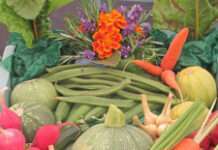Consumers are improving their understanding of health, food safety
MANHATTAN, Kan. – Kansas State University food scientist Karen Blakeslee said a recent survey by the U.S. Food and Drug Administration indicates that consumers are becoming more aware of how to use nutrition information in making healthier food choices.
Blakeslee noted findings that indicate the top four items that consumers read on a nutritional label are calories, total sugar, sodium and serving size.
“It is encouraging that consumers are reading the nutrition facts panel to help them choose healthier foods or reduce portion sizes,” said Blakeslee, who is also coordinator of K-State’s Rapid Response Center for food science.
The 2019 FDA Food Safety and Nutrition Survey report includes data collected from 4,398 respondents in late 2019. Some of the other key findings include:
• More consumers think it is ‘very common’ to get foodborne illness from food prepared in restaurants compared to home prepared food.
• Consumers are more concerned about raw meat or poultry contamination compared to raw vegetables and fruit.
• Most consumers have seen restaurant menu labeling and it has helped them avoid high-calorie foods.
Blakeslee said the responses indicate a continued need for food safety education.
“Consumers feel restaurants are the primary source of foodborne illness when – in many cases – improperly prepared food at home is the source,” she said. “Food safety is important at all levels of the food chain, including food prepared at home.”
Handling raw meat safely is important, but Blakeslee called it a “misunderstanding” to think that raw fruits and vegetables are low risk to food safety issues.
“The safest produce is when it is cooked,” she said. “The next safest step is rinsing produce with cold running water, especially for produce typically consumed fresh, such as leafy greens. Use a produce brush, or peel produce as an extra way to remove dirt and damage.”
“Also, check produce for bruises or damage. Keep cut produce refrigerated, and separate fresh produce from raw meat, poultry and seafood. And most importantly, wash your hands before handling any food, including fresh produce.”
Blakeslee said the Partnership for Food Safety Education has launched a public safety campaign to encourage those developing recipes to include food safety instructions. “Research has shown that this works and consumers are more willing to follow those directions,” she said.
The FDA’s survey will help in developing improved educational materials as well as guidelines and policy to better protect public health, Blakeslee said. But consumers still have a responsibility.
“Don’t forget that you are in control of handling food safety at home and also in choosing healthful, nutritious foods,” she said.
Blakeslee publishes a monthly newsletter, called You Asked It!, that addresses many issues related to food science and safety. More information on food safety also is available online from K-State Research and Extension.
FOR PRINT PUBLICATIONS: Links used in this story
Rapid Response Center for food science, www.rrc.ksu.edu
2019 FDA Food Safety and Nutrition Survey, https://www.fda.gov/food/science-research-food/2019-food-safety-and-nutrition-survey-report#
Partnership for Food Safety Education, www.fightbac.org
You Asked It! (newsletter), www.rrc.k-state.edu/newsletter/index.html
K-State Research and Extension Food Safety, www.ksre.k-state.edu/foodsafety/
K State Research and Extension is a short name for the Kansas State University Agricultural Experiment Station and Cooperative Extension Service, a program designed to generate and distribute useful knowledge for the well being of Kansans. Supported by county, state, federal and private funds, the program has county extension offices, experiment fields, area extension offices and regional research centers statewide. Its headquarters is on the K State campus in Manhattan. For more information, visit www.ksre.ksu.edu. K-State Research and Extension is an equal opportunity provider and employer.
Story by:
Pat Melgares
785-532-1160
[email protected]
For more information:
Karen Blakeslee
785-532-1673
[email protected]





